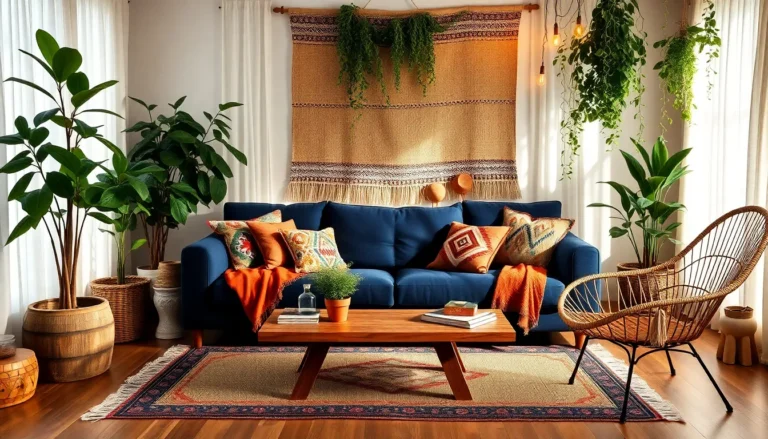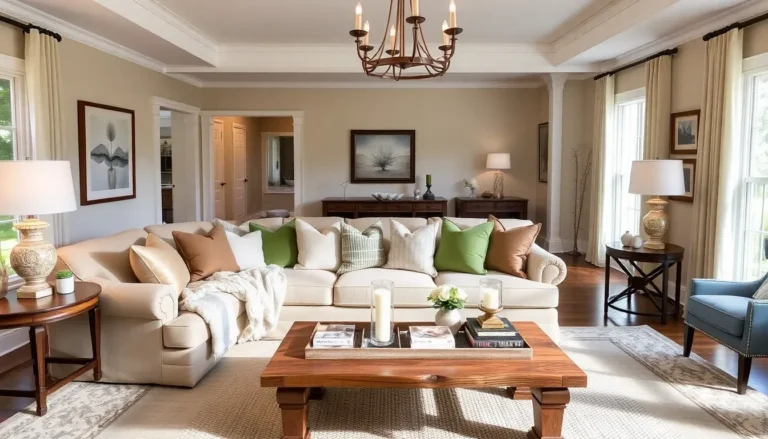Table of Contents
ToggleWhen it comes to living rooms, lighting can make or break the vibe. Picture this: you walk into a room that feels as cozy as a warm hug or as bright as a dentist’s office. Not quite the same, right? The right lighting not only sets the mood but also highlights your stylish decor, making your space feel inviting and alive.
Overview of Living Room Lighting
Living room lighting plays a crucial role in shaping the environment. Multiple layers of light ensure both functionality and aesthetics. Ambient lighting serves as the foundation, providing overall illumination. This includes ceiling fixtures or recessed lights that maintain a bright atmosphere.
Task lighting complements ambient light, focusing on specific areas where activities occur. Floor lamps and table lamps effectively illuminate reading nooks or game tables. Accent lighting adds depth and highlights design elements such as artwork or architectural features. Wall sconces and spotlights accurately accentuate these focal points.
Consideration of color temperature also impacts ambiance. Warmer light temperatures, around 2700K to 3000K, create a cozy and inviting feel. Higher temperatures, such as 4000K, produce a brighter and more energizing environment. Mixing different color temperatures can accommodate various moods.
The arrangement of light fixtures substantially affects the overall experience. Strategically placing lights at various heights enriches the visual dimension of the room. Incorporating dimmers provides versatility in adjusting brightness levels throughout the day. This flexibility allows for tailored experiences during gatherings or quiet evenings.
Choosing the right fixtures requires attention to the living room’s size and layout. Large spaces benefit from multi-light chandeliers, while smaller rooms suit pendant lights. Fixtures should align with the room’s decor style, ensuring harmony with furniture and color palettes. Each lighting component contributes to a cohesive design that enhances comfort and livability.
Types of Lighting

Different types of lighting create a balanced and inviting living room. Understanding these categories helps in selecting the best options for each space.
Ambient Lighting
Ambient lighting serves as the base layer of illumination, filling the entire room with a soft, warm glow. Overhead fixtures like chandeliers and ceiling-mounted lights provide this essential light source. This type of lighting not only facilitates movement but also enhances comfort and sets the room’s mood. Use dimmers with ambient sources to adjust brightness and tailor the ambiance to specific occasions.
Task Lighting
Task lighting focuses on specific areas where activities such as reading, crafting, or working occur. Table lamps and floor lamps designed for these functions provide direct light for increased visibility during detailed tasks. Positioning task lights near seating areas or workspaces ensures enough illumination without being harsh. Combining task lighting with ambient sources creates a layered approach that enhances both functionality and aesthetics.
Accent Lighting
Accent lighting draws attention to particular design elements, like artwork or architectural features. Spotlights, wall sconces, and LED strip lights are popular choices for highlighting these focal points. The contrast between accent lights and the ambient light adds depth and interest to a living room. Thoughtful placement of accent lighting transforms the space into a sophisticated showcase of style.
Factors to Consider
Choosing the best lighting for living rooms involves understanding multiple factors that affect both aesthetics and functionality. These key elements include room size and layout, color scheme, and functionality.
Room Size and Layout
Room size significantly influences lighting choices. Large living rooms often require multiple light sources to avoid dark corners, while smaller spaces benefit from layered lighting to create an illusion of openness. Positioning fixtures strategically enhances the layout, ensuring even light distribution. Overhead lighting complements floor and table lamps, resulting in a balanced atmosphere. Consider the arrangement of furniture; adjustable lamps can spotlight cozy seating since they aid specific areas effectively.
Color Scheme
Color scheme plays a vital role in lighting selection. Warmer tones tend to amplify coziness, making them ideal for inviting atmospheres. Cool colors, on the other hand, offer a more energizing feel. The finish of light fixtures can also impact color perception; for instance, metallic finishes reflect light, enhancing brightness. Choosing shades that harmonize with furniture and decor creates cohesion. Always consider how the lighting will affect the overall color palette, ensuring that hues complement rather than clash.
Functionality
Functionality determines the types of lighting required in a living room. Areas designated for reading benefit from focused task lighting, while ambient lighting supports a relaxed atmosphere. Combining these elements allows for versatility, transforming spaces for various activities. Dimmers offer flexibility, adjusting brightness to suit different moods or gatherings. Assess specific needs, such as lighting for entertainment or relaxation, making sure each fixture serves a distinct purpose without overwhelming the space.
Best Lighting Options for Living Rooms
Choosing the right lighting options can dramatically enhance the ambiance of any living room. Consider these popular choices for effective lighting.
LED Bulbs
LED bulbs provide efficiency and longevity, making them a top choice for living room lighting. With a lifespan of up to 25,000 hours, they reduce the need for frequent replacements. Energy consumption is significantly lower than traditional incandescent bulbs, leading to savings on energy bills. Additionally, LED options come in various color temperatures, allowing homeowners to select warm tones for coziness or cooler options for a vibrant atmosphere. The instant brightness of LED bulbs improves the overall illumination, contributing positively to the ambient light layer.
Floor Lamps
Floor lamps serve a dual purpose in living rooms, offering both style and functionality. They provide targeted light for reading or other activities, enhancing task lighting when positioned next to seating areas. Adjustable options allow users to customize the height and direction of light, providing versatility based on preferences. Many styles and designs exist, fitting different decor themes, from modern to traditional. Incorporating a floor lamp can effectively blend with other lighting types, adding layers to the overall brightness and character of the space.
Pendant Lights
Pendant lights offer striking statements while serving functional purposes in living rooms. Available in various styles, these fixtures can effectively accentuate specific areas, like coffee tables or seating arrangements. They create a focal point, drawing the eye upward and adding visual interest to the room. Moreover, pendant lights can provide a warm glow, enhancing the cozy atmosphere. Dimming options allow further control over brightness, adapting the lighting to different moods or activities. Including a few well-placed pendant lights can transform the living room’s layout and feel.
Tips for Effective Lighting Design
Effective lighting design transforms a living room’s ambiance. Strategic planning ensures a warm, inviting space while serving functional needs.
Layering Light
Layering light involves using various lighting types to enhance functionality and aesthetics. Ambient lighting sets the foundational glow, while task lighting targets specific activities like reading. Accent lighting emphasizes decorative elements, adding depth to the space. By combining these layers, a living room achieves balance and visual interest. Different sources, such as chandeliers, floor lamps, and wall sconces, can complement each other, creating a harmonious look. This approach allows flexibility in adjusting the lighting to suit different times of day or occasions.
Dimming Options
Incorporating dimming options enhances control over the living room’s atmosphere. Dimmers allow for adjustable brightness, accommodating various activities such as movie nights or lively gatherings. Choosing dimmable LED bulbs ensures energy efficiency while offering versatility. Additionally, using smart home technology can simplify lighting adjustments, enabling users to select preset moods. This flexibility allows individuals to create the desired ambiance, transforming the space with ease. Emphasizing the importance of dimmers can lead to a more customizable and enjoyable living environment.
Placement Strategies
Placement strategies matter significantly for effective lighting design. Position ambient lighting sources centrally to evenly distribute light throughout the room. Task lighting should be placed near activity areas, like reading corners or workspaces, providing ample illumination. Accent lighting can highlight artwork, architectural features, or decorative objects, drawing attention where desired. Ensuring that each type of lighting is strategically located creates a cohesive flow. By considering the room’s layout and function, individuals can enhance comfort and style in the living room.
Choosing the right lighting for a living room is essential for creating an inviting atmosphere and enhancing the overall decor. By understanding the different layers of lighting and their specific functions, one can achieve a balanced and visually appealing space.
Incorporating ambient, task, and accent lighting allows for versatility and personalization. The right fixtures and strategic placement can transform a living room into a cozy retreat or an energizing gathering space.
With options like LED bulbs, floor lamps, and pendant lights, it’s possible to combine style with functionality. Ultimately, thoughtful lighting design not only elevates the room’s aesthetic but also enhances comfort and livability.








